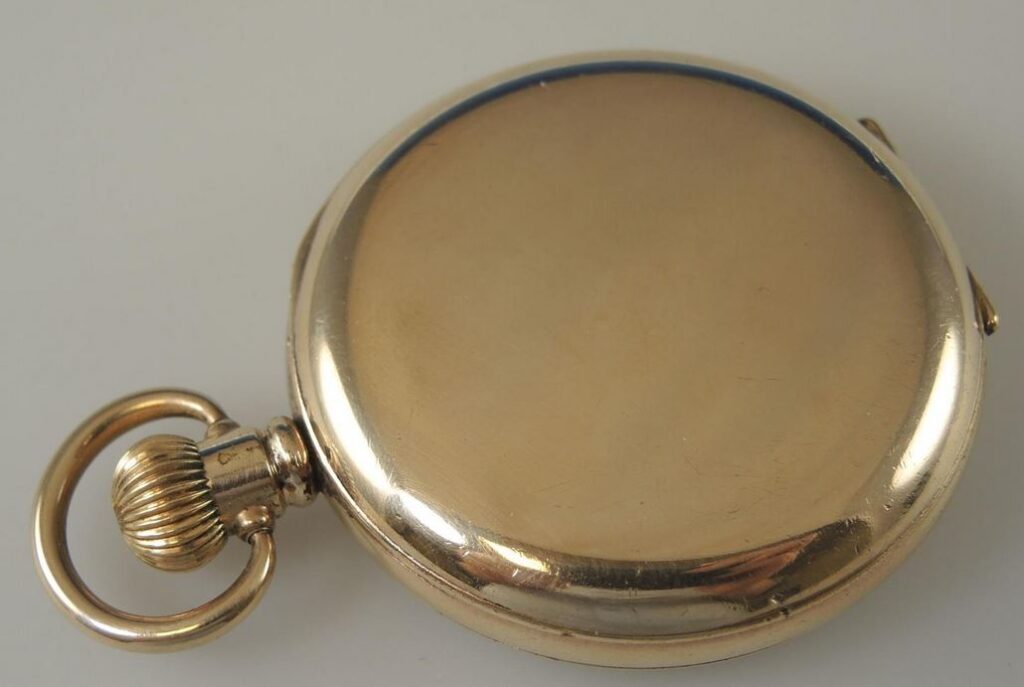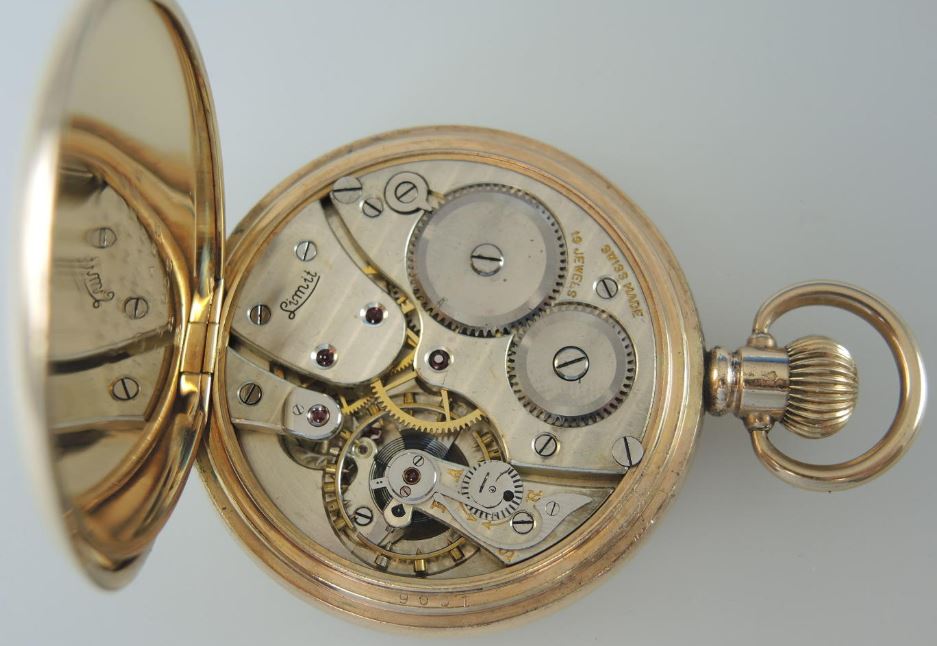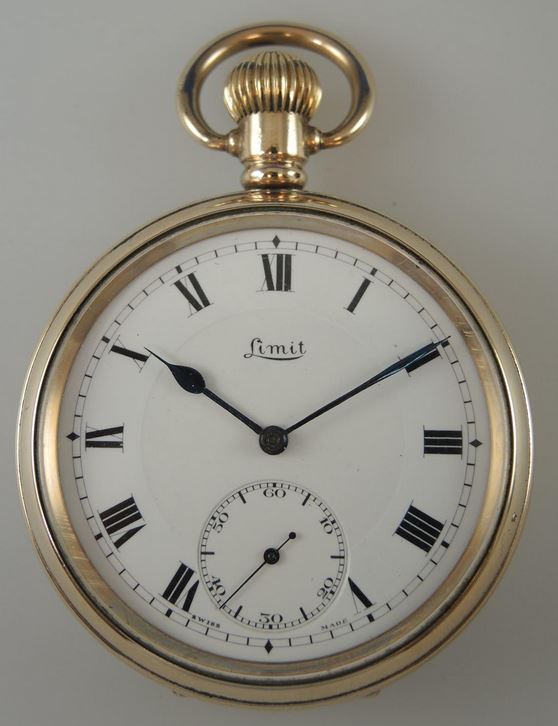Last updated on June 24, 2024
This antique Limit pocket watch was made by the English pocket watch company Hirst Brothers. They owned the brand name Limit. The movement was made in Switzerland and sent to England where it was placed in a high-quality gold-plated case. Limit has long been a brand name on my wish list. They have a long history and were known for producing good quality pocket watches from the late 19th century up until the 1960s.
Hirst Brothers
In August 1884, Alfred Hirst (1863 – 1925) established Hirst Brothers as a company in Union Street, Oldham, England. Hirst started his career as a watch repairer. However, it is not clear if he ever completed an apprenticeship as a watchmaker. Hirst Brothers was not a manufacturer, their watchmaking would have been limited to assembly and finishing. By 1894 the business was expanding and the company moved to larger premises in Curzon Street, Oldham. The name Limit was officially registered by Hirst Brothers in 1912. However, the brand name was in use before this time, possibly as early as 1908. The basic movements were shipped from the Thommen Waldenburg factory in Switzerland to the Oldham headquarters for assembly. They were placed into English made Dennison cases, and signed with the Limit brand name.
The First World War started in 1914. In line with the rest of the country, Hirst Brothers switched from normal production to the manufacture of wartime instruments. I have seen a few Limit watches that are dated to the war years, so some watch production continued. Interestingly, these war period watches were all pocket watches. I have not seen any trench watches made by Hirst Brothers.
After the war, normal production resumed and Hirst Brothers continued to expand. As a result, by the beginning of the 1920s, the company employed over 500 people. At this stage, the product range had expanded and included watches, clocks, jewellery, tools, and optical goods. Hirst Brothers suffered financial difficulties in the mid-1920s. They when into liquidation in 1926. The company survived after restructuring. However. the company was ultimately acquired by Time Products Limited in 1963.
Movement
The good quality nickel movement has a lever escapement with a micrometer regulator and a capped escape wheel. Micrometer regulators are typically used on higher-quality movements. This allows precision adjustments to be made to the oscillation rate of the balance wheel, changing the speed of the watch. All movements will contain a regulator. However, lower-quality movements usually do not contain an additional mechanism to allow for precision adjustments. The movement is jewelled to the centre and is decorated with striped damascening. The art of damascening involves the inlaying of different metals into one another. Typically, gold or silver is worked into a darkly oxidised steel background to produce intricate patterns. The English term is because of a perceived likeness to the rich tapestry patterns of damask silk. The movement is signed “Limit, 19 Jewels, Swiss Made” and is in near perfect condition.
Dennison case
The movement is fitted into a gold-plated Dennison open face case. It has hinged inner and back cases with a snap-on bezel. Aaron Lufkin Dennison (1812 – 1895) was an American-born businessman. He trained as a watchmaker and had a chequered career in the watch industry. He worked for several watchmaking companies, including one that was to eventually become the Waltham Watch Company. In 1864, Dennison set up another business, the Tremont Watch Company in Boston. He intended to use components from Swiss manufacturers because labour costs were lower. Dennison left a business partner in charge in Boston and moved to Switzerland to oversee operations. The Tremont Watch Company fell into financial difficulties in 1870. As a result, Dennison moved to England. In 1874, he founded the very successful Dennison Watch Case Company in Birmingham.
The case backs open cleanly with the use of a case knife and click solidly back into place. The gold-plated case has a smooth plain finish. It is in near perfect condition with only minor wear from normal use. There are no deep scratches. The gold plating has worn evenly and there are no signs of the underlying metal showing through.
Dial
The white enamel dial has a full set of blue steel hands. The bluing process tempers the steel and creates a protective oxidised coating that helps to prevent the hands from rusting. The process involves heating the hands, over a bed of brass filings, to a precise temperature. First, the steel hands are cleaned and polished before being heated. The bed of brass filings is used because it helps to maintain a stable temperature exchange. The steel changes colour from gold to brown and then purple before it settles to blue.
If it is heated further, the steel hand turns light blue and eventually light grey. Once the steel reaches the blue colour it is removed from the heat and quenched in oil. The challenge of creating blued steel is maintaining temperature control. Additionally, it is critical to remove the steel from the heat as soon as it reaches the desired colour. Modern watch hands are typically blued using a chemical process because it is cheaper and easier.
The double-sunk enamel dial is signed “Limit, Swiss Made”. The dial is in perfect condition, there are no signs of damage or hairline cracks. The Roman numeral hour markers are crisp, with no signs of fading.
The watch passed the timekeeping test, running within 1 minute’s accuracy over a 24-hour period. The power reserve on a full wind is approximately 35 hours. This is a remarkable number of hours for an antique watch. It exceeds the power reserve of any other watch in my collection. These factors exceed my requirements for a practical antique pocket watch. The watch is very presentable, being described by the seller (Atlam watches) as in mint condition. I agree with this view and I am very pleased with this new addition to my collection.



The movement is by the Swiss manufacturer Thommen. Limit imported them into the UK, where they were cased and finished. I have seen many, manufactured over several decades (as evidenced by silver and gold date-letter hallmarked cases) and they all have exactly the same layout of cocks and bridges. They come in various numbers of jewels, from 7 upwards, and were made in open-face and hunter layouts. All the movements are marked – presumably by Thommen – “Limit” and none seem to show any of the Revue or Gideon Thommen names or marks.
Thanks for the article, it helped me identify the movement in my grandfather’s Limit pocket watch, given to him in 1923…
Hi Patrick, glad to be of help. I hope you enjoy wearing your grandfather’s Limit pocket watch. Thanks for commenting, Jason.
Hi Jason, Yes his old watch ticks on my work table… I don’t carry it around given it’s age and importance to me…